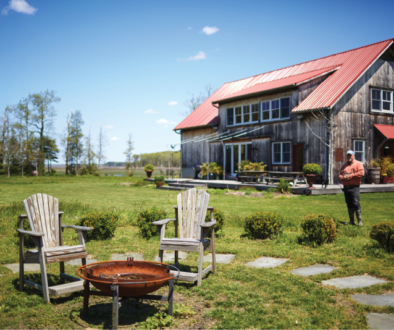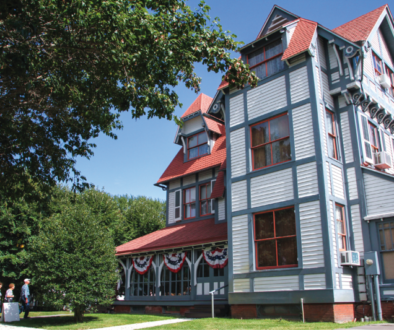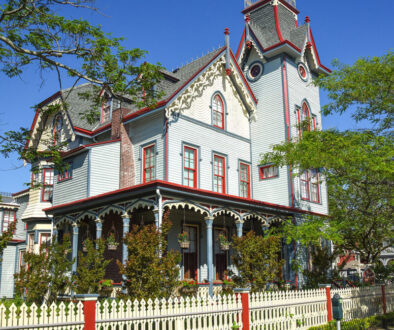The Vanishing Wetlands
A beautiful sea of grass is drowning.
In “Rosalita,” the classic tune by New Jersey’s unofficial troubadour, Bruce Springsteen, the Boss sings ruefully about his car getting bogged down in what today we’d call the wetlands:
And my machine, she’s a dud
Stuck in the mud
Somewhere in the swamps of Jersey.
The song, of course, was written back in 1973, three years after the first Earth Day, at the infancy of the brand new Environmental Protection Agency and just a year after the enactment of the Clean Water Act, long before anyone considered the idea of a Green New Deal. It wasn’t unusual then to dismiss the vast coastal wetlands and tidal salt marshes that mark the Jersey shore from Cape May up to, yes, Asbury Park and beyond as “mud” and “swamps.”

But if you hop into your machine today and cruise northward on the Garden State Parkway, for mile after mile on your right you’ll gaze out on a vast stretch of shimmering grasses undulating gently in the breezes from the ocean. It’s a heart-stoppingly beautiful, living and breathing expanse of green, stretching from the Delaware Bay around the Cape May peninsula and up past Barnegat Bay and as far north as the Meadowlands, covering more than 300,000 acres.
And it’s more than beautiful. It’s an ecological treasure, vitally important to New Jersey, and to the world. However, thanks to overdevelopment and the effects of climate change and rising sea levels, the iconic salt marshes along the Jersey shore are disappearing, and fast. Said one scientist who’s studied the area: “Somebody in 50 years who looks at some of the marshes we’ve looked at, they’ll just see lots of open water.”
As the ocean inches ever higher, it threatens the very survival of the area. “The marshes are drowning,” says Lenore Tedesco, the executive director of the Wetlands Institute in Stone Harbor, which last year celebrated the 50th anniversary of its founding in 1969. “The rate of sea level rise is exceeding the level at which the marshes can keep up. That’s why the alarm bells are ringing.”
The sea of grasses growing along New Jersey’s Atlantic coastline, especially in the back bay and intracoastal zone between the mainland and the barrier islands, contributes to the state’s well-being in many ways.
The tidally influenced marshes and wetlands are like a huge pantry, buffet, and takeout restaurant for fish and wildlife. Countless creatures are born, thrive, grow old and die in and around the marshes, and others stop over for rest and to recuperate on their way somewhere else. The marshes, too, serve as a giant workshop to clean, polish and restore the soil, the water, and the air, often removing harmful or toxic chemicals.
Over time, the marshes act as a sink in which millions of tons of carbon accumulate and is stored in the form of dead and decaying grasses that collapse into the muck, preventing that carbon from contributing to the greenhouse gases already piling up in the earth’s atmosphere. According to the EPA, the marshes “improve water quality, including that of drinking water, by intercepting surface runoff and removing or retaining inorganic nutrients, processing organic wastes, and reducing suspended sediments” before they reach the open waters of the ocean.
Another important, if less obvious role played by the swath of coastal wetlands is to protect against flooding and coastal erosion, so that big chunks of New Jersey don’t gradually fall into the sea. (That’s not as crazy as it sounds. Since the late 1600s, the entire coastline of New Jersey has been eroded inland by 2,000 feet, due to the constant churning power of the Atlantic Ocean.) And besides normal erosion, the marshes defend the state in moments of crisis. They act as a natural shock absorber that protects the land against destruction caused by hurricanes, nor’easters, and high tides. During Superstorm Sandy in 2012, for instance, the marshes saved property owners an estimated $625 million in damages, according to Christopher Hilke, senior manager for climate adaptation and resilience at the National Wildlife Federation’s Northeast division.

“Coastal wetlands are some of the most productive ecosystems on earth,” Hilke adds. “They provide habitats for a huge number of species, rare species like the roseate tern, the salt marsh sparrow, and piping plover, as well as habitats for migratory shore birds along the Atlantic flyway, and nursery habitats for a whole host of recreational fisheries, lobster and herring.” As many as 95 percent of commercial fish and 85 percent of recreational fish use coastal wetlands and related river systems for feeding, breeding and shelter, according to the NWF.
Plus, the wetlands and marshes have an important recreational value for boaters, kayakers, birders, and nature lovers of all kinds. “It’s just the intrinsic beauty of nature,” says Tedesco. “People love looking out over a vast marsh area at sunset.”
A huge ecosystem like the salt marshes and wetlands along the Jersey shore is very complex, and figuring out how it might react to rising oceans is as much an art as a science. But there’s no question that rising sea levels pose a dire threat to the health and, eventually, to the very existence of the marshes.
At the Wetlands Institute, Tedesco says they’re planning for a sea level that she expects will be two to three feet higher than it is now within 30 to 40 years. Scientists have provided various models about what that might mean for the marshes. According to one calculation, three feet of sea level rise could permanently destroy 46 percent of all the salt marshes worldwide. Other predictions are even more dire. The New Jersey Department of Environmental Protection cites one calculation that concludes that “89 percent of New Jersey’s salt marshes will disappear with a one-foot rise in sea levels, and 95 percent will be inundated with a three-foot rise.”
It’s already underway. According to the Association of State Wetland Managers, across the country more than 80,000 acres of wetlands are lost every year due to the effects of climate change and sea level rise. The science, explains the association on its website, is quite straightforward.
“First, as the oceans absorb excess CO2 from the atmosphere, it causes ocean temperatures to rise, which expands the volume of water in the ocean. Second, as average global temperatures increase, arctic glaciers and ice caps melt, adding additional volume to ocean water levels. As a result, and in combination with other drivers of change (e.g., subsidence, land conversion/alteration, and increased hurricane activity), coastal wetlands have been lost at an alarming rate.”
The problem is worse in New Jersey because the entire southern half of the state is gradually sinking, a holdover from the Ice Age thousands of years ago. An enormous ice mass covered northern New Jersey back then, weighing it down and causing south Jersey to rise upward, like a seesaw. When the ice melted, southern New Jersey began tipping downward, a tiny fraction of an inch every year. So, Cape May is sinking just as the ocean is rising around it.


Some people dispute the science, especially the well-established research showing that the accelerating rate of global warming is the result of man’s actions, particularly the burning of fossil fuels that adds billions of tons of carbon dioxide to the atmosphere every year. “Our marshes are the canary in the coal mine,” says Tedesco—an ironic metaphor given that coal mines are one of the chief causes of climate change.
But the marshes and wetlands have developed a survival technique. Most of New Jersey’s coastal wetlands and salt marshes exist along a gently sloping plane that drops down gradually as it meets the ocean. From prehistoric times and until about a hundred years ago, the marshes had a unique and elegant way of adapting to coastal erosion and to the rising sea levels that followed the end of the Ice Age. The edge of the marshes closest to the ocean would eventually be inundated, its soil eroded, and it would disappear into the sea. But as the sea encroached on its turf, the far end of the marshes would migrate landward, moving ever further west. Like the living thing that it is, it slowly marched up and away from the ocean, and it’s been doing so for countless centuries.
With development along the coast, however, we’ve “hardened” the landward side of the wetlands expanse. Oceanfront development, barriers and bulkheads, and other manmade obstructions have effectively prevented most of the marshes from continuing this age-old survival technique. “And,” says Tedesco, “we’ve built a wall called the Garden State Parkway straight along the coast, so we’ve effectively limited the ability of the marshes to move inland.”
Now, accelerated sea level rise is making that problem a lot worse than it was, say, half a century ago. The salt marshes are literally stuck between a rock and wet place. They have nowhere to go.
Even a few inches of sea level rise can make a difference. The grasses that dominate the salt marshes – especially the species known as saltmarsh cordgrass (Spartina alterniflora), which is mostly what you see along the parkway – are highly sensitive to the depth of the water in which they live, and even small changes in the water’s depth can drastically affect their growth. Sitting in her office at the Institute, Tedesco sees the changes day after day. “The Institute itself is super vulnerable now,” she says. “As I look out my window, since I’ve been there, the amount of time the marsh is completely inundated now is common. It’s frequent. For the first time ever there’s water in the boathouse, and that happens 30 or 40 times a year now.”
Lots of people—scientists, government officials, activists, and environment and nonprofit organizations—are hard at work trying to figure out what to do about the threat to the marshes.
First, of course, there’s the big picture. It’s become clear to almost anyone paying attention that the world as a whole has to grapple with the urgent challenge of slowing down and eventually reversing the effects of the increase of carbon dioxide in the atmosphere, and that means most of all the rapid elimination of fossil fuels and a switch to renewable energy (solar, wind, water) along with much greater energy efficiency.
But, just as the city of Cape May is planning to build stronger coastal defenses against rising seas [see “Hell and High Water,” by Bob Dreyfuss, Cape May Magazine, Spring 2020], there are efforts underway to plan the defense of the tidal wetlands, too.
One solution, still in the experimental stage, involves dredging the silt from waterways that crisscross the marshes and, using a kind of cannon or a set of pipes, spreading it onto the grassy marsh, a process called “thin spreading.” The aim is to try to elevate the marshland itself, raising it a few inches to get ahead of the rising sea. These efforts started in Stone Harbor and Avalon about five years ago, according to Tedesco, who adds that there are five such projects underway now up and down the shore. “The idea has been around for a long time,” she says. “And we’re still learning from these projects.” But it will take some time to figure out whether it’s a viable, long-term solution, and in any case it’s probably far too expensive to do for many thousands of acres that might need it.
“The jury is still out on the effectiveness of dredging, for a number of reasons,” says NWF’s Hilke, citing a number of challenges posed by thin spreading, especially how to maintain a standard thickness of the added silt. “It’s hard to get an even coat across the marsh.”
Another solution might be to use New Jersey’s Blue Acres and Green Acres programs to create room along the landward side of the marsh for them to continue their westward march. That, experts say, would involve removing or softening some of the barriers, bulkheads, and development along the coast, either by buying out homes and businesses (especially flood-prone ones) and turning those areas into open spaces. In addition, environmentalists favor what are called living shorelines—that is, shores made up of natural or living materials rather than “hard” barriers.
“In certain locations, there is nothing we can do to preserve the marsh, except possibly the idea that infrastructure can be removed. A sea wall can be removed, and replaced with a living shoreline,” says Hilke. “The question is, can we moving forward reduce the amount of hardening while also protecting those areas of tidally influence wetlands where we can?”
Of course, it’s not just New Jersey’s problem. Marla Stelk is executive director of the Association of State Wetland Managers, and she stays in touch with officials across the country who are facing similar problems. In the mid-Atlantic region, she says, New York, Delaware and Maryland all face problems related to sea level rise and wetlands. “All the coastal states are thinking about it, and trying to come up with solutions,” she says. “There’s no easy answer. Unfortunately, some states have been told that they can’t use the words ‘climate change,’ so they’ve had to tiptoe around it. There are still some states who can’t talk about climate change with the media.”
“We need a thousand small solutions,” said Tedesco in a recent TED Talk. Her goal, she said in the talk, is “to move out of what I call the climate change denial bubble. … I’m trying to move the dialogue about climate change from denial to problem solving and planning.”
Speaking to Cape May Magazine in May, Tedesco seemed to express the belief that New Jersey can manage to deal with the challenges it faces. “Change is the norm,” she says. “I look at the work we’re doing now as like, it’s kind of a wildfire that we’re in the middle of.”
If we can save some of the threatened species, if we can protect the marshes and eventually allow them to spread out again once the danger from climate change has eased, then we can count that as a success, says Tedesco. “That’s how I look at the work I’m doing now.”



